1. Hungry Hungry Hippos (1978): The Ultimate Marble-Chomping Frenzy
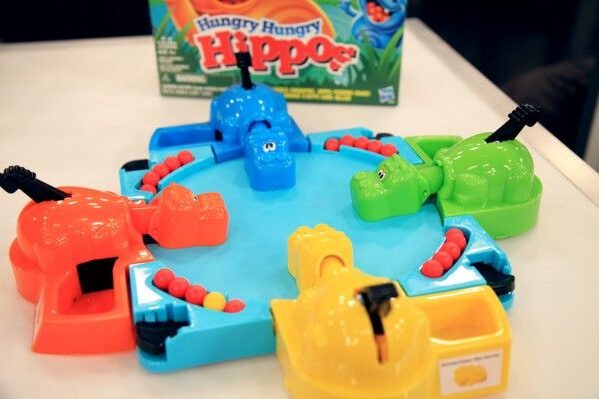
When Hungry Hungry Hippos was released by Milton Bradley in 1978, it became an instant sensation, delivering a type of manic, high-energy fun that no other board game had at the time. Unlike strategy-based games that required patience and planning, Hungry Hungry Hippos was all about speed, reflexes, and sheer chaos. The game board featured four brightly colored hippos—each controlled by a player—lined up around a pit of marbles in the center. The goal was simple but electrifying: press the lever as fast as possible to make your hippo’s mouth chomp down and gobble up as many marbles as you could before they were all gone. The sound of the plastic hippos snapping wildly at the marbles, combined with the excited yells of kids trying to out-chomp each other, made this one of the noisiest and most action-packed games of the decade. It was the perfect choice for kids who loved competition, as the game often ended in frantic laughter, accusations of cheating, and demands for a rematch.
What made Hungry Hungry Hippos even more beloved was how easy it was to play—there were no complicated rules, no dice to roll, and no waiting for turns. Even younger children could jump in without any learning curve, making it one of the best party games of its time. Families often found themselves playing multiple rounds, with kids determined to perfect their lever-slamming technique to ensure their hippo dominated the board. Despite the fact that the game itself had no deeper strategy or long-term replayability, it never got boring because of the sheer physical engagement it required. Parents may have cringed at the relentless clattering noise, but for kids in the ’70s, Hungry Hungry Hippos was pure, unfiltered fun that got their hearts racing and their competitive spirits soaring. Even today, seeing that bright orange, green, pink, and yellow set of hippos is enough to bring back a wave of nostalgia for those who grew up in this unforgettable era of gaming.
2. The Game of Life: Animal Kingdom Edition (1971): A Wild Twist on a Classic

In 1971, Milton Bradley took one of its most famous board games, The Game of Life, and gave it an exciting, wildlife-themed twist that was both educational and adventurous, according to Hands on Exotics. Instead of making choices about careers, houses, and family life, players followed the journey of an animal, experiencing the highs and lows of life in the wild. The board was divided into different natural habitats, including dense forests, scorching deserts, vast oceans, and icy tundras, with each environment presenting its own unique challenges. As players moved through the game, they encountered real-life struggles that animals face—finding food, escaping predators, migrating to safer areas, and even dealing with changing seasons. The game introduced kids to the concept of survival in nature in a way that felt immersive and exciting, making it a hit among young animal lovers and future conservationists.
One of the most memorable aspects of The Game of Life: Animal Kingdom Edition was the way it blended fun with learning. Each card drawn gave players interesting facts about different species, explaining how they adapted to their environments, how they hunted or evaded being hunted, and how their lives depended on maintaining balance within their ecosystems. This was one of the first mainstream board games to incorporate an environmental message, subtly teaching kids about wildlife conservation long before it became a global movement. Although this version of the game wasn’t as widely distributed as the original Game of Life, those who played it in the ’70s still remember the thrill of guiding their chosen animal through the unpredictable twists and turns of survival. It was a game that left a lasting impact, giving children a new appreciation for the natural world while keeping them entertained with its adventurous, storytelling-based gameplay.
3. Mouse Trap (1963, but a ’70s Staple): The Most Elaborate Rube Goldberg Game
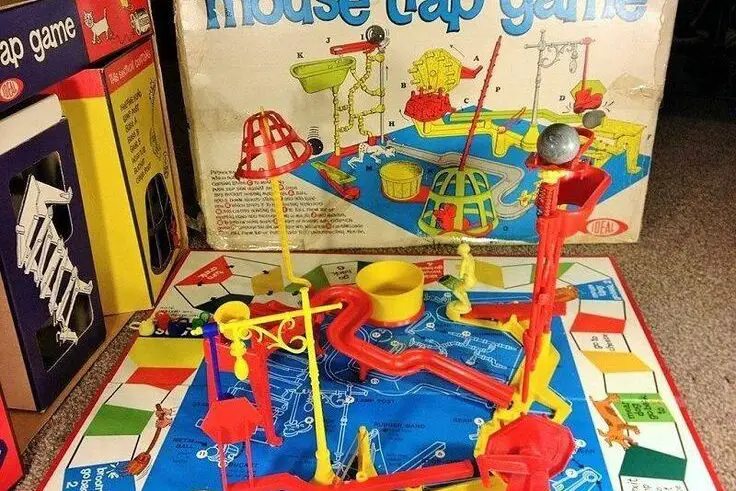
Although Mouse Trap originally debuted in 1963, it became a household favorite in the ’70s, captivating kids with its incredibly intricate, hands-on mechanics. Unlike traditional board games that relied on rolling dice and moving pieces along a track, Mouse Trap was about building a complex, wacky contraption designed to catch a tiny plastic mouse. The board itself served as a blueprint for a Rube Goldberg-style machine, with players gradually adding gears, slides, a seesaw, a rolling ball, a swinging boot, and, finally, a little metal cage that would (hopefully) drop at the right moment to trap a mouse. The joy of the game wasn’t just in winning—it was in the thrilling process of constructing the elaborate device and anticipating whether or not it would work as intended.
However, part of what made Mouse Trap so legendary was how unpredictable it was. Sometimes, the contraption worked flawlessly, setting off a satisfying chain reaction that led to a perfectly executed mouse capture. Other times, the delicate setup would fail spectacularly—pieces would topple over too early, the rolling ball would get stuck, or the final cage wouldn’t drop at all. This led to endless giggles, frustration, and demands for a do-over, making it one of the most interactive and unpredictable board games of its time. The game encouraged a love for mechanics and problem-solving as kids tried to figure out exactly what went wrong and how to fix it. Even though it was originally released in the ’60s, it was in the ’70s that Mouse Trap truly found its place as a beloved game-night staple, cementing its legacy as one of the most entertaining, hands-on experiences a child could have at the time.
4. Cootie (1970s Edition): Build a Bug, Piece by Piece
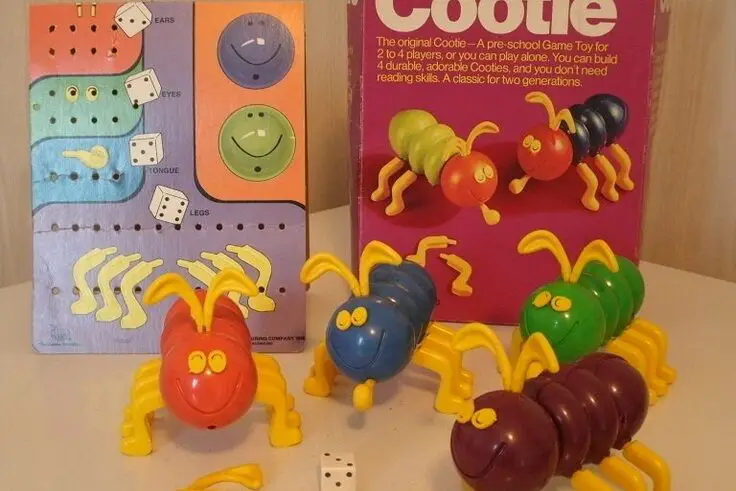
The Cootie Game was one of the most delightfully simple yet endlessly entertaining games that kids of the 1970s adored. Originally invented in the 1940s, Cootie had a major revival in the ’70s with a fresh, colorful redesign that made it a must-have for younger children. According to Wikipedia, the concept was brilliantly straightforward—players took turns rolling a die to collect different body parts to assemble their very own goofy-looking “Cootie” bug. Each player started with an empty plastic bug body and had to add legs, antennae, eyes, and a wiggly tongue piece by piece, with the goal of being the first to complete their wacky creature. There was something oddly satisfying about snapping the bright, chunky plastic parts together, and kids loved watching their silly, oversized bugs take shape. The game wasn’t about strategy or competition so much as it was about pure, hands-on fun, making it an especially popular choice for younger siblings who wanted to join in on game night without complicated rules.
What made Cootie particularly memorable was its tactile, interactive nature—instead of just moving a piece around a board, kids were actively building something with their hands, which made the experience feel more engaging than a standard roll-and-move game. The unpredictability of the dice roll added an element of anticipation as players excitedly hoped for the right number to attach their next piece while laughing at the half-built, goofy-looking Cooties sitting on the table. Parents loved it because it kept little ones occupied for a long time, and unlike many board games, Cootie didn’t cause major arguments or frustration since there were no tricky mechanics involved. While the game may seem simplistic by today’s standards, for ’70s kids, the joy of piecing together their very own funny, bug-eyed creatures made Cootie a nostalgic classic. Even today, vintage Cootie sets are a prized find at flea markets and thrift stores, reminding collectors of a time when fun was as easy as rolling a die and building a bug.
5. Shark Attack! (Late ’70s Prototype): The Game That Never Officially Released
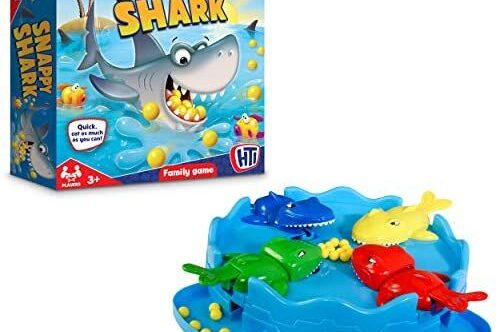
Shark Attack! was one of the most heart-pounding, adrenaline-fueled board games that ’70s kids almost got to experience—though it wouldn’t officially hit store shelves until the early 1980s. However, in the late ’70s, a few early prototypes were being tested, and those lucky enough to play it during this experimental phase still recall the sheer thrill and terror of trying to escape a mechanical shark. Unlike traditional turn-based board games, Shark Attack! had a real-time action element, making it feel more like a high-stakes survival challenge than a standard roll-and-move experience. Players controlled tiny fish-shaped pieces that moved around a circular board, desperately trying to avoid a large, motorized shark that actually moved on its own and chomped up pieces as it advanced. The tension was sky-high as the shark crept closer, and kids would scream in excitement and panic as they scrambled to get their fish to safety before being swallowed whole.
The game stood out because it introduced an unexpected level of suspense and action that most board games at the time lacked. While other games relied on dice and strategy, Shark Attack! was all about quick reflexes and split-second decisions, creating a sense of urgency that made it feel almost like an arcade game. Kids loved the idea of an automated enemy relentlessly hunting them down, making every move feel like a desperate attempt to survive. Even though this version of the game wasn’t officially released until the early ’80s, the few ’70s kids who got their hands on a prototype knew they had experienced something special. It was one of those rare board games that actually got your heart racing, which was a big deal in an era dominated by slower-paced, strategy-based games. Today, Shark Attack! is remembered fondly as one of the first truly action-packed, anxiety-inducing board games, proving that sometimes the most unforgettable childhood memories come from the moments when you feel like you’re really in the middle of an adventure.
6. Grape Escape (Late ’70s Toy Prototype): The Squishy Game That Was Ahead of Its Time
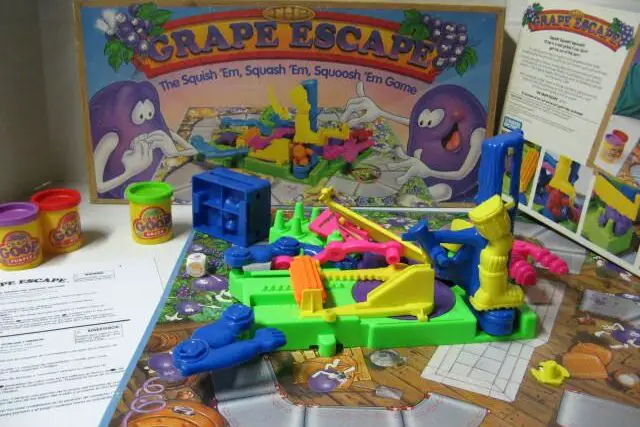
While Grape Escape wouldn’t gain widespread popularity until the 1990s, the concept of a squishy, moldable board game had its origins in the late ’70s with an early, experimental version that few kids got to experience. This was a game where you didn’t just play with pieces—you created them. Players used soft, malleable material (similar to Play-Doh) to mold their own little grape characters and then guided them through an obstacle course full of silly, cartoonish traps designed to squish, chop, and mash them into oblivion, according to Wikipedia. The board was filled with hilarious contraptions, including rolling pins, presses, and hammers, all designed to destroy your poor grape character if you weren’t careful.
What made this game unique for ’70s kids was its hands-on, creative aspect, something that very few games at the time incorporated. Instead of static, plastic playing pieces, you were actively shaping and reshaping your characters, which meant that every game felt different. There was a sense of lighthearted destruction—kids found it hilarious to see their squishy little grapes get flattened or chopped in half, only to mold a new one and try again. The game was oddly satisfying, combining creativity, unpredictability, and slapstick humor into one ridiculous experience. Even though it wouldn’t hit mainstream success until years later, ’70s kids who got their hands on this early prototype knew they were playing something way ahead of its time, proving that sometimes the weirdest and most experimental games leave the biggest impact on childhood memories.
7. Don’t Spill the Beans (1970s Edition): A Game of Balance and Tension
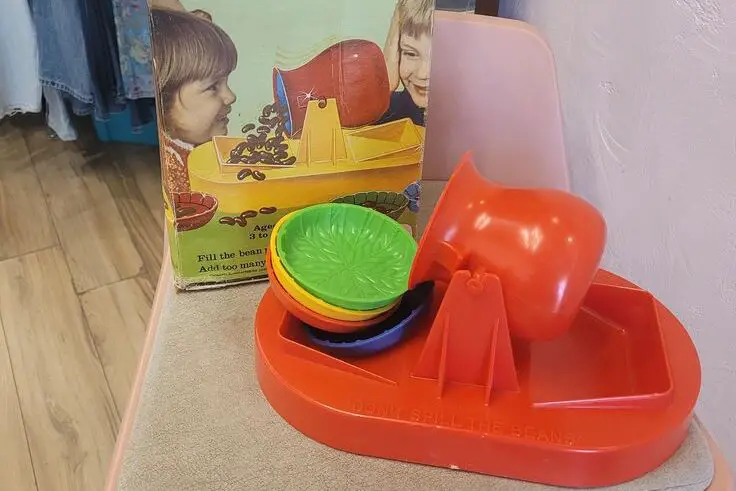
Don’t Spill the Beans was one of those rare games that managed to be deceptively simple yet endlessly nerve-wracking, making it a favorite among ’70s kids who loved a good challenge. The game featured a plastic, tilting pot that wobbled precariously on a pivot, and players took turns placing tiny plastic beans onto it, one by one. The goal was to keep the pot steady while making it harder for the next player, knowing that at some point, the weight would become too much and the whole thing would come crashing down in a dramatic spill. Unlike many competitive games that relied on speed or strategy, Don’t Spill the Beans was a test of patience, precision, and a steady hand—kids would hold their breath as they carefully positioned each bean, hoping to avoid being the unlucky one who sent them all flying.
What made this game so beloved was the sheer anticipation and tension it created. Every turn felt like a high-stakes moment, especially as the pot became increasingly unstable, tilting back and forth with even the slightest movement. The laughter and shrieks that followed a bean avalanche were legendary, and no matter how many times kids played, they never got tired of the heart-pounding excitement of waiting for the inevitable spill. Parents appreciated that it was easy to learn and required no batteries or complicated setup, making it a go-to game for family nights and sleepovers. It also had the unique ability to bring out kids’ sneaky competitive sides—some would try to delicately balance their beans in the perfect spot, while others would strategically place them just right to make things extra unstable for their opponents. Don’t Spill the Beans may have been a simple game, but for ’70s kids, it was an unforgettable lesson in suspense, strategy, and the fine art of bean placement.
8. Crocodile Dentist (Late ’70s prototype): The Original Tooth-Pulling Thriller

Though Crocodile Dentist didn’t become widely popular until the early 1990s, the first experimental versions of this game were floating around in the late ’70s, and kids who got their hands on it still remember the heart-pounding thrill of dodging a sudden snap from the plastic croc’s jaws, according to Wikipedia. The premise was brilliantly simple yet packed with tension—a green plastic crocodile had a set of teeth, and players had to take turns “fixing” its dental problems by pressing down on one tooth at a time. But hidden among the harmless teeth was one unlucky tooth that would trigger the crocodile’s mouth to snap shut in a dramatic chomp. The suspense was electrifying—each press felt like a game of Russian roulette, and kids would squeal with delight (or terror) when the croc decided it had had enough.
What made Crocodile Dentist stand out was its combination of surprise, humor, and physical interaction—unlike traditional board games where you simply moved pieces around, this one created a real, visceral reaction with every turn. The tension of wondering if you’d be the unlucky player added an edge of excitement that made the game wildly addictive. Kids would try to strategize, examining the croc’s teeth carefully as if they could somehow predict which one was the “bad” tooth, even though it was completely random every time. Some players even tried to test the waters with a light tap, hoping to avoid a full press that might set off the snap. The thrill of barely escaping, combined with the inevitable shrieks when someone finally triggered the bite, made Crocodile Dentist a game that ’70s kids who played the early versions would never forget.
9. Let’s Go Fishin’ (1973): The Spinning Pond of Frenzied Fishing Fun
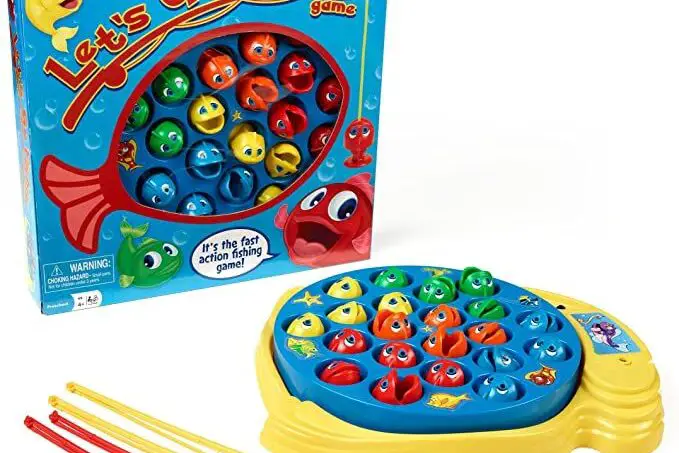
For ’70s kids who loved games with a little bit of action and a lot of excitement, Let’s Go Fishin’ was an absolute must-have. The game featured a bright blue plastic “pond” filled with colorful, motorized fish that opened and closed their mouths as they spun around on a rotating base. Players were given tiny fishing poles and had to hook as many fish as possible before time ran out. While it seemed like a simple concept, the challenge of actually catching the fish was much harder than it looked—the fish’s mouths snapped shut quickly, and if you didn’t time your move just right, your hook would miss, or worse, you’d lose a fish you had just barely caught. Kids quickly learned that precision, timing, and fast reflexes were key, making this game equal parts frustrating and addicting.
The spinning, unpredictable nature of Let’s Go Fishin’ made it an absolute blast, especially when multiple kids were playing at once, all frantically trying to snag fish before their siblings or friends did. The competition was fierce—some players developed secret strategies, like hovering their hook over a certain section of the pond or trying to predict the movement of the fish. Others would get so into it that they’d accidentally knock the whole pond over, sending fish flying in every direction (a sure way to end the game in chaos and laughter). Parents loved that it helped kids develop hand-eye coordination, though they probably didn’t love the noisy, whirring motor that played in the background throughout every game. But for ’70s kids, the thrill of hooking that last, elusive fish made Let’s Go Fishin’ one of the most exciting, fast-paced games of the decade.
10. Ants in the Pants (1970s Edition): The Ultimate Test of Flicking Precision
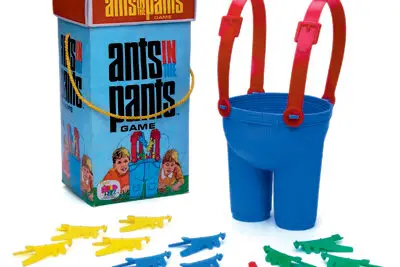
For ‘1970s kids who loved games that involved both skill and silliness, Ants in the Pants was an absolute classic. The game featured a large, plastic pair of overalls standing upright, with an open top meant to act as the “pants.” The goal was simple yet ridiculously challenging—each player was given a set of small, springy plastic ants, and they had to use their fingers to flick the ants into the pants. It sounded easy in theory, but the ants had minds of their own, often bouncing wildly in every direction except where you wanted them to go. According to Ultra Board Games, players would adjust their flicking techniques, experimenting with angles, pressure, and even lucky superstitions to land the ants successfully inside. The game required a mix of patience, fine motor skills, and a whole lot of laughter, especially as players watched their ants land on the table, floor, or even their opponent’s lap instead of in the pants.
What made Ants in the Pants a favorite among ‘70s kids was the chaotic, fast-paced energy it brought to game night. Since all players could flick their ants simultaneously, the game quickly turned into a frenzy, with kids scrambling to launch as many ants as possible before someone else won. The unpredictability of the flicking mechanism made it just as frustrating as it was hilarious, with some ants stubbornly refusing to go in, no matter how many times they were flicked. There was always that one lucky player who somehow managed to sink all their ants effortlessly, leaving everyone else in disbelief. The game was pure, lighthearted fun, requiring no complex rules or strategy—just a willingness to laugh at yourself when your ants failed spectacularly. Parents appreciated that it was easy to set up and didn’t require batteries, making it a staple for playdates, rainy afternoons, and family gatherings.
11. Barrel of Monkeys (1970s Edition): The Game That Tested Patience and Precision
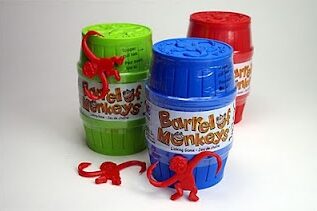
For ‘70s kids, Barrel of Monkeys was one of those deceptively simple yet surprisingly frustrating games that could keep them entertained (and occasionally exasperated) for hours. The game consisted of a brightly colored plastic barrel filled with small plastic monkeys, each with curved arms designed to hook onto one another. The goal was straightforward: dump out the monkeys, pick one up, and then carefully hook as many as possible into a growing chain without dropping them. At first glance, it seemed like a game purely based on fun, but players quickly realized that it required a surprising amount of skill, patience, and a steady hand. The moment a single monkey slipped, the entire chain would collapse, sending kids back to square one in a mix of frustration and laughter.
What made Barrel of Monkeys so appealing was the way it challenged kids’ fine motor skills while still feeling lighthearted and silly. Some players mastered the art of strategic hooking, figuring out the best way to hold their monkeys to keep the chain balanced, while others just hoped for the best, giggling as their monkeys tumbled apart. It was a game that could be played solo for personal records or with friends in competitive monkey-linking showdowns. The simple yet addictive nature of the game made it a popular choice for road trips, sleepovers, and even classroom breaks since it didn’t require a board or any complicated setup. Kids took pride in seeing how long they could make their monkey chain, and there was nothing more satisfying than linking every single monkey together without a single fumble. It may not have had flashing lights or sound effects, but for ‘70s kids, Barrel of Monkeys was a pure, tactile joy that never got old.
Click here for more stories like this
12. Tip-It (1970s Edition): The Balancing Game That Tested Dexterity and Nerves
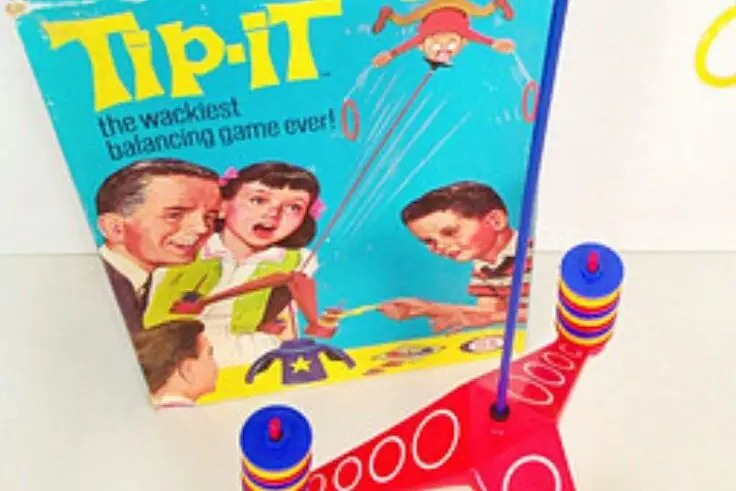
For ‘70s kids who loved games that required steady hands and nerves of steel, Tip-It was the ultimate test of balance and skill. The game featured a tall, spinning pole with multiple plastic arms extending outward, each holding small, weighted discs. The goal was simple yet incredibly tense—players took turns removing the discs with a small hook while keeping the entire structure from tipping over. At first, it seemed easy, as the base remained steady and players carefully plucked off discs without much trouble. But as more discs were removed, the pole became more unstable, wobbling dangerously with every tiny movement. The tension in the room grew as players leaned in, holding their breath, hoping their delicate maneuver wouldn’t send the entire thing crashing down. The slightest mistake—a shaky hand, an overconfident move, or an accidental bump—could cause the whole structure to collapse, sending plastic pieces flying across the table and players into fits of laughter or groans of defeat.
What made Tip-It so exciting was its perfect blend of skill, suspense, and sheer luck. Unlike games based purely on speed or randomness, this one rewarded patience and careful precision, making it feel almost like a game of operation but with a more unpredictable twist. Kids often tried to develop their own strategies, some believing a slow, deliberate approach was best, while others took a risky, fast-paced strategy that either paid off spectacularly or resulted in instant disaster. Parents loved the game because it helped develop hand-eye coordination and concentration, but for kids, it was all about the thrill of teetering on the edge of success or total collapse. Whether it was played at sleepovers, family game nights, or after-school hangouts, Tip-It was the kind of game that could turn even the steadiest hands into a bundle of nerves. And when that final, fateful disc sent the whole structure toppling, there was only one thing left to do—reset the game and try again.
13. The Game of Cat & Mouse (1974): A Fast-Paced Chase to Outrun the Cat
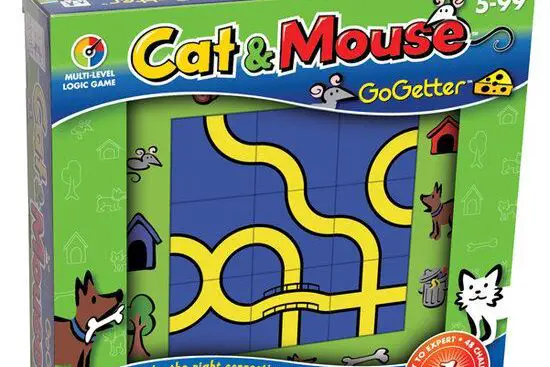
The Game of Cat & Mouse was a lesser-known but deeply beloved board game from the 1970s that brought a level of suspense and strategy that made it stand out from other kids’ games of the era. The board featured a colorful path shaped like a wedge of Swiss cheese, with tiny plastic mice as the players’ pieces and a looming cat figure ready to pounce. The goal was to move your mouse around the board, collecting cheese pieces while avoiding the cat’s grasp. The catch? The cat moved, too, creating an intense game of cat-and-mouse suspense (literally) as players nervously planned their next move, hoping to stay ahead of their feline pursuer. The game required just the right mix of luck and strategy, as kids tried to determine the safest paths while keeping a close eye on the unpredictable cat’s movements.
What made this game special was its nail-biting tension—every dice roll felt like a matter of life and death for your poor little mouse. Players would let out dramatic sighs of relief when they barely escaped a close encounter, while others would shout in frustration when the cat landed exactly where they didn’t want it to. Unlike most board games where every player had the same goal, The Game of Cat & Mouse felt truly dynamic and immersive, making kids feel like they were living out a real chase scene from a cartoon. There was an element of unpredictability that kept players coming back for more, determined to outsmart the cat and win the cheese. Though not as widely remembered as some of the bigger titles from the era, this game left a lasting impression on the kids who played it, proving that sometimes the simplest ideas make for the most unforgettable childhood memories.


